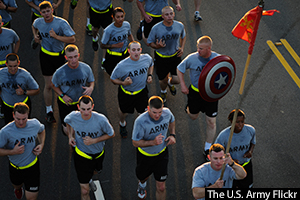Sep 24, 2013
Last year, 325 soldiers died by suicide.
In response to these starting numbers released earlier this year, the Army has designated September as  Suicide Prevention Month, and this military service branch has spearheaded a new and ongoing effort to foster resiliency in soldiers, prevent and reduce the record number of suicides and remove the stigma associated with behavioral health treatment.
Suicide Prevention Month, and this military service branch has spearheaded a new and ongoing effort to foster resiliency in soldiers, prevent and reduce the record number of suicides and remove the stigma associated with behavioral health treatment.
The Army’s Ready and Resilient Campaign is that effort. The campaign, which began in March, is a three-phase plan that strives to “enhance individual resilience and unit readiness across the total Army family—active duty soldiers, National Guardsmen, reservists, civilians and family members,” wrote Lt. Col. S. Justin Platt, director of public affairs for the Army G-1 Office, which is helping to coordinate and facilitate the campaign, in an email. “In support of this campaign, for example, we’ve incorporated resilience training into all educational and professional development programs. Soldiers of all ranks must practice skills that build resilience as part of the collective effort to sustain a strong Army team.”
Platt wrote that the campaign “synchronizes and integrates key Army programs that focus on building resilience, reinforcing prevention, and supporting the reduction of suicide and suicidal ideation, sexual harassment and sexual assault, bullying and hazing, substance abuse, domestic violence and stigma barriers associated with seeking help.”
The Army defines resiliency as the “mental, physical, emotional and behavioral ability to face and cope with adversity, adapt to change, recover, learn and grow from setbacks.”
Platt stated that the Army is focusing on resiliency in soldiers due to the impact of more than 10 years of war.
“[The] Army leadership has observed some negative impacts on the force,” Platt wrote. “It’s also important to remember that sources of stress for our soldiers exist outside the combat experience, as members who have never deployed also encounter challenges. Additionally, financial, family and social pressures play a role in a soldier’s journey to resilience.”
The campaign is directed to soldiers throughout the Army’s hierarchy of leadership, from commanders to noncommissioned officers (NCOs) at the unit level. Resiliency training is achieved through the Army’s Comprehensive Soldier and Family Fitness (CSF2) program, which provides hands-on training and self-development tools.
Col. Kenneth Riddle, director of CSF2, wrote in an email that CSF2 “addresses the antecedents to suicide,” and is “a key component of the Ready and Resilient Campaign.”
Through CSF2, the Army provides the Master Resilience Trainer (MRT) course for NCOs, Army civilians and even Army spouses. According to the CSF2 website, the MRT curriculum focuses on self-awareness, self-regulation, optimism, mental agility, strengths of character, and connection with others. The course includes individual assessments and virtual and classroom training.
Riddle wrote that NCOs are the target audience of MRT “because they touch/train soldiers every day.”
MRT is a 10-day train-the-trainer course. When an individual completes the training, he or she is certified to serve as a Master Resilience Trainer at the unit level.
“These MRTs are expected to go back to their unit or Family Readiness Group and pay that training forward by training other soldiers, spouses and Army civilians,” Riddle wrote. “The end result being a total Army team of physically healthy and psychologically strong soldiers, families and civilians.”
Riddle wrote that it is an Army requirement to have one Master Resilience Trainer per company and one Army civilian MRT per 250 Army civilians. It is an objective of the Army to have one Army spouse MRT per company Family Readiness Group.
Since MRT began three years ago, the Army has trained more than 18,000 Master Resilience Trainers, although not all of them are still in the Army.
Riddle wrote that family members are included in resiliency training because they are the strength behind soldiers.
“It is critical that Army families are speaking the same language of resilience, and are able to grow in their personal and professional lives by leveraging the skills and the tools available to them as a family unit,” he wrote.
The first Spouse Master Resilience Trainer course pilot was held last year at Fort Campbell, KY, and the second pilot was this year held at Fort Carson, Colo.
Riddle wrote that institutional resilience training is provided at every level of the Army’s educational system, from basic training to the War College. CFS2 is currently piloting a training support package that will eventually be used every time a soldier in-processes to a new Army installation.
Prior to the implementation of the resiliency training, the Army partnered with the National Institute for Mental Health (NIMH) in 2009 to launch Army Study of Assess Risk and Resilience in Service members (Army STARRS) and address the issue of suicide. The project includes investigators from the Uniformed Services University of Health Services, Harvard Medical School, University of Michigan and University of California, San Diego.
During the five-year study, which will conclude in June, researchers are working to “find factors that protect a soldier’s well-being and factors that put a soldier’s mental health at risk,” according to the NIMH website.
“Army STARRS is not an intervention project,” Platt wrote. “Rather the primary focus at this point in time is to identify groups of soldiers at heightened risk for suicide, so that the Army might better focus its intervention and prevention resources. Army STARRS primary intent is to provide evidence-based research which will inform/shape the Army’s policy, programs, training and budget within the Ready and Resilient Campaign.”
A key step in preventing and reducing suicide is the ability of soldiers to ask for help and seek mental health treatment. A goal of the Ready and Resilient campaign is to reduce the stigma associated with behavioral health treatment and Platt wrote that the Army is making progress in this area.
“As part of the Army’s ongoing stigma reduction efforts, we treat invisible wounds as we do visible wounds,” he wrote. “When soldiers seek or have been identified as needing help, it is the commander’s/leader’s responsibility to ensure the soldiers get the assistance they deserve. Keep in mind that we must accomplish the Army’s mission and ensure the well-being of the soldier. The Army has the ability to reclassify a soldier into a new military occupational specialty to achieve this mission.”
“Stigma creates barriers to help seeking behavior and can adversely impact readiness. … Over the past few years, we have seen a decrease in the percentage of soldiers that don’t seek help,” he continued. “At the same time, the number of soldiers who are using treatment programs such as behavior al health and substance abuse has steadily increased, which indicates soldiers are overcoming those barriers. It will take time to change the Army’s culture, but through actions and example, Army leaders are beginning that transformation.”
Lisa R. Rhodes is a journalist and a member of NAMI Prince George’s County in Maryland.

